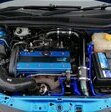
Bert
-
Posts
1048 -
Joined
-
Days Won
15
Reputation Activity
-
.png) Bert got a reaction from xXGEIGERXx_ in how to get better hit detection
Bert got a reaction from xXGEIGERXx_ in how to get better hit detection
You wouldn’t be blaming hitdetection for your loss if you were that good at the game
These traffic prio rules only function under the condition that your line is congested. Then it works because you get a buildup of packets in the sending que and it can put game traffic in front of the que. If no congestion occurs then each packet is send inmediately and the rule does nothing. Running QoS requires packet inspection and that does add latency, this is the trade-off for running QoS on your system. So therefore in situations with symmetrical connections with very few devices I would always recommend turning off QoS totally as this gives you the cleanest path for traffic. Ie I have 600/40 connection in one house where that connection services the whole home, there I have QoS on because it’s easy to congest a 40mbit upload line. In my other house I have 2x 600/600 WAN and the connection that is used for gaming doesn’t use QoS at all since I never congest it with just 1 PS4 and 1PC.
As for DumaOS classified games vs manual rules. You could argue that other UDP traffic will try to get in front of your gaming traffic (DumaOS classified games simply prioritizes UDP 1024-65535) but in reality this is not noticeable unless you are running something special that generates a huge UDP stream. And here again, it would require the line to be congested in the first place. Also you could add the device as game console and then it simply prioritizes UDP traffic to that device.
The only reason I use a manual rule is so that my bandwidth is not restricted when the game is running idle in the menu.
There is really no magic traffic prioritization rule. You will find many topics about it, people have spend countless hours with wireshark etc but none have the magic answer.
-
.png) Bert got a reaction from purpleandgold33 in CALL OF DUTY IS MANIPULATING YOU
Bert got a reaction from purpleandgold33 in CALL OF DUTY IS MANIPULATING YOU
You need a rig that can produce 540 FPS to be able to take advantage of that, even with a 4090 or 7900XTX you will not see those framerates.
Also the difference is getting smaller every time you up the Hz rating:
60 Hz = 16,6ms between frames
120 Hz = 8,3ms between frames
240 Hz = 4,2ms between frames
360 Hz = 2,7ms between frames
540 Hz = 1,9ms between frames
For the amount of manipulation happening from the game, ie active latency balancing and skill based matchmaking I would not invest in anything over average hardware as it's simply pointless. Even stuff like routers. Average home net has 1ms between device and router and for a fiber connection you have 1ms between device and ISP node. Do you really think QoS and all this BS matters if the game simply matches your latency in lobby to the other players? You can't even tell if you are playing on a 10ms, 30 ms or 50ms server in game due to the lag compensation systems.
-
.png) Bert got a reaction from Nalsano_ in CALL OF DUTY IS MANIPULATING YOU
Bert got a reaction from Nalsano_ in CALL OF DUTY IS MANIPULATING YOU
You need a rig that can produce 540 FPS to be able to take advantage of that, even with a 4090 or 7900XTX you will not see those framerates.
Also the difference is getting smaller every time you up the Hz rating:
60 Hz = 16,6ms between frames
120 Hz = 8,3ms between frames
240 Hz = 4,2ms between frames
360 Hz = 2,7ms between frames
540 Hz = 1,9ms between frames
For the amount of manipulation happening from the game, ie active latency balancing and skill based matchmaking I would not invest in anything over average hardware as it's simply pointless. Even stuff like routers. Average home net has 1ms between device and router and for a fiber connection you have 1ms between device and ISP node. Do you really think QoS and all this BS matters if the game simply matches your latency in lobby to the other players? You can't even tell if you are playing on a 10ms, 30 ms or 50ms server in game due to the lag compensation systems.
-
.png) Bert got a reaction from N3CR0 in CALL OF DUTY IS MANIPULATING YOU
Bert got a reaction from N3CR0 in CALL OF DUTY IS MANIPULATING YOU
You need a rig that can produce 540 FPS to be able to take advantage of that, even with a 4090 or 7900XTX you will not see those framerates.
Also the difference is getting smaller every time you up the Hz rating:
60 Hz = 16,6ms between frames
120 Hz = 8,3ms between frames
240 Hz = 4,2ms between frames
360 Hz = 2,7ms between frames
540 Hz = 1,9ms between frames
For the amount of manipulation happening from the game, ie active latency balancing and skill based matchmaking I would not invest in anything over average hardware as it's simply pointless. Even stuff like routers. Average home net has 1ms between device and router and for a fiber connection you have 1ms between device and ISP node. Do you really think QoS and all this BS matters if the game simply matches your latency in lobby to the other players? You can't even tell if you are playing on a 10ms, 30 ms or 50ms server in game due to the lag compensation systems.
-
.png) Bert got a reaction from TrayDay in CALL OF DUTY IS MANIPULATING YOU
Bert got a reaction from TrayDay in CALL OF DUTY IS MANIPULATING YOU
You need a rig that can produce 540 FPS to be able to take advantage of that, even with a 4090 or 7900XTX you will not see those framerates.
Also the difference is getting smaller every time you up the Hz rating:
60 Hz = 16,6ms between frames
120 Hz = 8,3ms between frames
240 Hz = 4,2ms between frames
360 Hz = 2,7ms between frames
540 Hz = 1,9ms between frames
For the amount of manipulation happening from the game, ie active latency balancing and skill based matchmaking I would not invest in anything over average hardware as it's simply pointless. Even stuff like routers. Average home net has 1ms between device and router and for a fiber connection you have 1ms between device and ISP node. Do you really think QoS and all this BS matters if the game simply matches your latency in lobby to the other players? You can't even tell if you are playing on a 10ms, 30 ms or 50ms server in game due to the lag compensation systems.
-
.png) Bert got a reaction from Krush in NEW XR500 BETA FIRMWARE: 3.3.535
Bert got a reaction from Krush in NEW XR500 BETA FIRMWARE: 3.3.535
I tried updating from .134 and that seems to do the trick.
I was at a DumaOS 3 beta previously. going intermediate firmware -> RC10 -> RC14 gave issues. Maybe updating needs to be done from .134 and not from a previous beta.
-
.png) Bert got a reaction from Martdog23 in SQM?
Bert got a reaction from Martdog23 in SQM?
At 1Gbit up and down you should switch off QoS entirely unless you use a huge amount of bandwidth.
QoS is the thing that is probably least understood by gamers but it does for sure sell routers. If you are not reaching the maximum of your connection then there is no packets stuck in the queue and QoS will not do anything for you.
Also say you have 500mbit. You go testing bufferbloat, adjust it to 400mbit. Great but if you are using the net by yourself and your average traffic use while gaming is 1mbit instead of downloading stuff, here QoS will again do nothing for you.
QoS actually slows down your traffic in terms of latency. Generally this little bit of latency is accepted by getting constant performance in return. A household with kids going off a 100/10 connection or so needs QoS but not at 1000/1000.
And yes for 1Gbit SQM you need a lot of CPU power. As far as I know only x86-64 routers are capable of doing this at this present time.
-
 Bert got a reaction from Krush in FTTH 8GB Download... interest ?
Bert got a reaction from Krush in FTTH 8GB Download... interest ?
Depends on really.
The 8Gbit we are supposed to get comes with a router that has 2.5Gbit ports so you can't use 8Gbit for a single device. That's why it's offered cheap as they think that nobody is able to use 8Gbit anyway. (I think XGS-PON can supply 10Gbit to a node so you would be almost saturating the entire node) But offcourse we won't be happy with that
10Gbit infrastructure is not that cheap yet though. If you buy the equipment new. You need a 10Gbit card in every PC or use mainboards that have 10Gbit included ($$$$). 10Gbit capable switches are also on the pricy side. I went with a switch that supports both 10Gbit and 2.5 Gbit as I think 2.5Gbit will gain more traction for home use, you can see PC mainboards utilizing this a lot more over 10Gbit and things like NAS devices as well. It's only a matter of time before TV's, consoles and streaming devices will switch to 2.5Gbit. Reason is that it's a lot more power efficient over 10Gbit. 10Gbit switches need active cooling so are usually on the noisy / power hungry side.
Then depending on the usecase, both your PC and your other sources need to be able to go up to 10Gbit speeds. Most NAS devices for home will not make this, hence why 2.5Gbit is rising in popularity. My servers are Intel Xeon with PCIE 3.0 NVME drives in RAID so they have no issue keeping up. And workstation is AMD 5950X with PCIE 4.0 drive, Sabrent Rocket. For a single file, say copy a 20GB DVD file, takes 20 seconds to copy, 100 GB takes under 2 minute, can't beat that with walking around with a external SSD.
Also for latency it makes a difference. At 1Gbit, local latency is about 1ms on LAN. At 10Gbit, latency is 0.25ms. While it does not sound like much, working on network shares feels like the drives are physically in your PC, they are much more responsive then on 1Gbit. The real reason for wanting the 8Gbit WAN over 1Gbit WAN though is that I have a second place in another country that already has 1Gbit FTTH (and they are slowly scaling up to 2Gbit), and use a site to site wireguard VPN to access the same server, where as the internet connection at my place where the server is has a low 40mbit upload now that is holding back transfers. For connections over distance it's actually better to have some overhead as latency quickly kills speed.
Also what helps loads for big file transfers is loads of RAM. When you download something, the NIC will write to memory and then to the drive. Windows utilizes 10% memory for this. So for a PC with 32 GB memory, it's full at 3GB and then you are most likely to see drops in transfer speed as memory needs to be flushed to the drives. Windows Server uses 50% so a server with 64 or 128 GB memory that can be used for 50% is more likely giving better results. Also for slower PC's RSS (recieve side scaling) needs to be enabled so incoming transfers will be distributed over multiple cores rather than 1 core. And something that is an issue with current retail PC's is the number of PCI-E lanes. Most have 20 so you use 4x for the SSD boot drive and 16x for the Graphics card. So that means that the 10Gbit NIC is generally located on the chipset / south bridge hogging up 4x PCI-E lanes. In reality for fastest transfers you would want both the NIC connected to the CPU and also a 2nd SSD drive connected to the CPU but that brings you into the territory of workstation PC's, Intel Xeon and AMD Threadripper.
Going above 1Gbit bandwidth for sustained transfers actually poses a lot of bottlenecks.
-
.png) Bert got a reaction from Theheadski in MW2 Shoot First Die first? how to fix this?
Bert got a reaction from Theheadski in MW2 Shoot First Die first? how to fix this?
What he was referring to is artificial latency balancing.
Paper from 2005:
https://www.researchgate.net/publication/220982447_Achieving_fairness_in_multiplayer_network_games_through_automated_latency_balancing
Basically they attempt to balance out latency server side by adding additional latency to players with fast internet. And that paper describes tech from 2005.
This is also the reason why P2P games always felt more responsive, they eliminated host advantage but didnt balance the clients.
So indeed it makes little difference playing on 20ms or 50ms ping etc.
-
.png) Bert got a reaction from Netduma Fraser in Is there a way to watch network traffic other than wireshark?
Bert got a reaction from Netduma Fraser in Is there a way to watch network traffic other than wireshark?
In order to do what Fraser says you need to have a managed switch that allows for port replication. For example Netgear GS305E, typically 30 bucks on Amazon. Hub will also work but not even sure if you can still buy those, if so they will usually only be 10/100 mbit. And you need a second device, ie PC or Laptop running the wireshark software and connect to that port.
Alternative is going to the router's debug page (for example 192.168.1.1/debug.htm change IP to yours) and there is an option to replicate the router's WAN port to LAN1 to do a wireshark capture. Same as with a switch you need to connect a PC/Laptop to that and use wireshark.
-
.png) Bert got a reaction from N3CR0 in Share Your Netduma Settings For MW/CW/WZ
Bert got a reaction from N3CR0 in Share Your Netduma Settings For MW/CW/WZ
If you played a few rounds and did well SBMM is most likely also going to get the best of you.
If you're on console, playing with crossplay on vs PC players can be quite a handfull. I play MW and CW on PC now and there is quite a difference in performance.
-
.png) Bert got a reaction from Newfoundland in SQM?
Bert got a reaction from Newfoundland in SQM?
At 1Gbit up and down you should switch off QoS entirely unless you use a huge amount of bandwidth.
QoS is the thing that is probably least understood by gamers but it does for sure sell routers. If you are not reaching the maximum of your connection then there is no packets stuck in the queue and QoS will not do anything for you.
Also say you have 500mbit. You go testing bufferbloat, adjust it to 400mbit. Great but if you are using the net by yourself and your average traffic use while gaming is 1mbit instead of downloading stuff, here QoS will again do nothing for you.
QoS actually slows down your traffic in terms of latency. Generally this little bit of latency is accepted by getting constant performance in return. A household with kids going off a 100/10 connection or so needs QoS but not at 1000/1000.
And yes for 1Gbit SQM you need a lot of CPU power. As far as I know only x86-64 routers are capable of doing this at this present time.
-
.png) Bert reacted to lefteris.lydios in how to get better hit detection
Bert reacted to lefteris.lydios in how to get better hit detection
It will never cease to amaze me how people think that manipulating their connection will make things better in this game.
-
.png) Bert got a reaction from N3CR0 in how to get better hit detection
Bert got a reaction from N3CR0 in how to get better hit detection
Different router brands have different notations for this. Some other let you specify both inbound and outbound separately and some always assume source to be the sender. DumaOS combines both directions but in reality inbounds means forwarding incoming WAN traffic to LAN and vice versa. On more professional systems you would add a rule to the WAN interface SRC 3074 DST 30000-45000 and Ethernet interface SRC 30000-45000 DST 3074. The rule is always applied to sending traffic since the interface can not control the receiving side. Ie you can not control what you will receive over the internet.
also it’s really simple to check if you’re rule is actually working. Look at the packet counter, for games WW2 and later it should add 60 packets under ‘prioritized’ for every second you play the game, both inbound and outbound. Unless it’s private games they have different tickrates in a lot of cases.
TCP is only used for communication to the back end servers, uploading stats etc so doesn’t affect your gameplay.
-
.png) Bert got a reaction from N3CR0 in how to get better hit detection
Bert got a reaction from N3CR0 in how to get better hit detection
You wouldn’t be blaming hitdetection for your loss if you were that good at the game
These traffic prio rules only function under the condition that your line is congested. Then it works because you get a buildup of packets in the sending que and it can put game traffic in front of the que. If no congestion occurs then each packet is send inmediately and the rule does nothing. Running QoS requires packet inspection and that does add latency, this is the trade-off for running QoS on your system. So therefore in situations with symmetrical connections with very few devices I would always recommend turning off QoS totally as this gives you the cleanest path for traffic. Ie I have 600/40 connection in one house where that connection services the whole home, there I have QoS on because it’s easy to congest a 40mbit upload line. In my other house I have 2x 600/600 WAN and the connection that is used for gaming doesn’t use QoS at all since I never congest it with just 1 PS4 and 1PC.
As for DumaOS classified games vs manual rules. You could argue that other UDP traffic will try to get in front of your gaming traffic (DumaOS classified games simply prioritizes UDP 1024-65535) but in reality this is not noticeable unless you are running something special that generates a huge UDP stream. And here again, it would require the line to be congested in the first place. Also you could add the device as game console and then it simply prioritizes UDP traffic to that device.
The only reason I use a manual rule is so that my bandwidth is not restricted when the game is running idle in the menu.
There is really no magic traffic prioritization rule. You will find many topics about it, people have spend countless hours with wireshark etc but none have the magic answer.
-
.png) Bert got a reaction from Nalsano_ in how to get better hit detection
Bert got a reaction from Nalsano_ in how to get better hit detection
You wouldn’t be blaming hitdetection for your loss if you were that good at the game
These traffic prio rules only function under the condition that your line is congested. Then it works because you get a buildup of packets in the sending que and it can put game traffic in front of the que. If no congestion occurs then each packet is send inmediately and the rule does nothing. Running QoS requires packet inspection and that does add latency, this is the trade-off for running QoS on your system. So therefore in situations with symmetrical connections with very few devices I would always recommend turning off QoS totally as this gives you the cleanest path for traffic. Ie I have 600/40 connection in one house where that connection services the whole home, there I have QoS on because it’s easy to congest a 40mbit upload line. In my other house I have 2x 600/600 WAN and the connection that is used for gaming doesn’t use QoS at all since I never congest it with just 1 PS4 and 1PC.
As for DumaOS classified games vs manual rules. You could argue that other UDP traffic will try to get in front of your gaming traffic (DumaOS classified games simply prioritizes UDP 1024-65535) but in reality this is not noticeable unless you are running something special that generates a huge UDP stream. And here again, it would require the line to be congested in the first place. Also you could add the device as game console and then it simply prioritizes UDP traffic to that device.
The only reason I use a manual rule is so that my bandwidth is not restricted when the game is running idle in the menu.
There is really no magic traffic prioritization rule. You will find many topics about it, people have spend countless hours with wireshark etc but none have the magic answer.
-
.png) Bert got a reaction from GBDJG in how to get better hit detection
Bert got a reaction from GBDJG in how to get better hit detection
You wouldn’t be blaming hitdetection for your loss if you were that good at the game
These traffic prio rules only function under the condition that your line is congested. Then it works because you get a buildup of packets in the sending que and it can put game traffic in front of the que. If no congestion occurs then each packet is send inmediately and the rule does nothing. Running QoS requires packet inspection and that does add latency, this is the trade-off for running QoS on your system. So therefore in situations with symmetrical connections with very few devices I would always recommend turning off QoS totally as this gives you the cleanest path for traffic. Ie I have 600/40 connection in one house where that connection services the whole home, there I have QoS on because it’s easy to congest a 40mbit upload line. In my other house I have 2x 600/600 WAN and the connection that is used for gaming doesn’t use QoS at all since I never congest it with just 1 PS4 and 1PC.
As for DumaOS classified games vs manual rules. You could argue that other UDP traffic will try to get in front of your gaming traffic (DumaOS classified games simply prioritizes UDP 1024-65535) but in reality this is not noticeable unless you are running something special that generates a huge UDP stream. And here again, it would require the line to be congested in the first place. Also you could add the device as game console and then it simply prioritizes UDP traffic to that device.
The only reason I use a manual rule is so that my bandwidth is not restricted when the game is running idle in the menu.
There is really no magic traffic prioritization rule. You will find many topics about it, people have spend countless hours with wireshark etc but none have the magic answer.
-
.png) Bert got a reaction from N3CR0 in how to get better hit detection
Bert got a reaction from N3CR0 in how to get better hit detection
I have used them both (manual rules and duma classified games) and know for fact there is no difference.
-
.png) Bert got a reaction from N3CR0 in how to get better hit detection
Bert got a reaction from N3CR0 in how to get better hit detection
The point was that both traffic prioritization and DMZ have totally different functions and have nothing to do with eachother.
If a user wants to use QoS they need to set this up separately from DMZ.
-
.png) Bert got a reaction from CRarsenxL in how to get better hit detection
Bert got a reaction from CRarsenxL in how to get better hit detection
You need to specify its UDP.
I have source 3074-3076 destination 30.000-45.000 but the above will also work.
my rule only comes on when you’re in the lobby so there is game traffic, it will turn off when you’re idle in the menu. Also 3076 is only because I have multiple ps4s, with only on console you can also set 3074-3074.
-
.png)
-
.png) Bert got a reaction from Newfoundland in ANNOUNCEMENT: DUMAOS 3.0 IS HERE
Bert got a reaction from Newfoundland in ANNOUNCEMENT: DUMAOS 3.0 IS HERE
To be fairly honest, I think it's also because there is less of a market for the XR700.
It's a niche product compared to the XR500.
The biggest failure of the XR700 is supplying only 1 SFP port. Because of this, you either have the option of running a 2.5-5-10G internet connection, but you have no way to transmit this to your network, outside of wifi.
Or, you run a 1000/1000 internet connection and use the 10G port to link up to a 10G capable switch or a NAS. This is really the best use case scenario. Where this comes in handy is if you are doing a lot of streaming from local sources. Since you could run a NAS or something else at 10G instead of gigabit. That eliminates any sort of congestion. Or use link aggregation to the NAS and hook up a 10G switch. Your devices can make full use of the NAS without congesting the link between router and switch.
If it had 2 SFP ports you could run 10G LAN and link up to a 10G switch. This would have been a much better scenario altough by the time 10G LAN will become mainstream, the wifi is outdated anyhow.
-
.png) Bert reacted to Netduma Fraser in ANNOUNCEMENT: DUMAOS 3.0 IS HERE
Bert reacted to Netduma Fraser in ANNOUNCEMENT: DUMAOS 3.0 IS HERE
If they were about to be EOL then we wouldn't be spending all this time trying to get 3.0 working on each router properly and running a beta for each, just would not be a good use of dev time if that were to be the case. Our routers have always been a decent price, it's not a case of undercutting them at all. If people want the higher hardware option then that's what the XR series is for. With ours we're aiming to get DumaOS in the hands of those on a budget and get updates out faster. Just depends on what you would prefer. I think it actually complements the XR series well. I can assure you the partnership is going strong.
-
.png) Bert got a reaction from CrophiXx in ANNOUNCEMENT: The Netduma R2 is here
Bert got a reaction from CrophiXx in ANNOUNCEMENT: The Netduma R2 is here
Do you know this from actual testing?
That would be a serious letdown if it can't handle a gigabit connection since that is rapidly becoming the standard in most places.
-
.png) Bert reacted to Newfoundland in ANNOUNCEMENT: The Netduma R2 is here
Bert reacted to Newfoundland in ANNOUNCEMENT: The Netduma R2 is here
I think Killhippie has answered it for you and please forgive me but I can’t discuss this further at this time.





.thumb.png.b557c3bb447a49e0a75d1e277fc31813.png)

